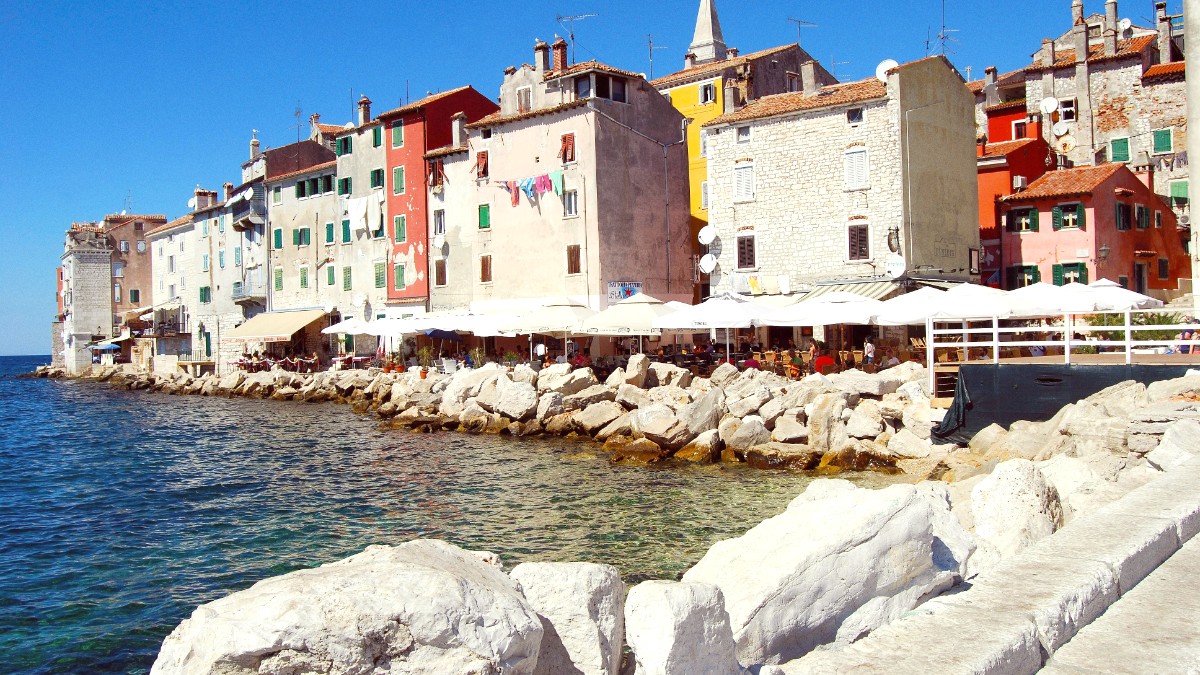
Istria, Croatia
Rovinj's landmarks showcase its rich history and strategic coastal position. They are enduring symbols of the town's heritage.
From a commanding hilltop church to ancient gates and a lively harbor, these sites offer both historical narrative and picturesque views.
Dress respectfully when entering the church (shoulders and knees covered).
A 17th-century arch serving as the main entrance to the Old Town from Tito Square. Features a Venetian lion and a Turkish head carving. A popular photo spot, marking transition to ancient streets.
The lively harbor area for fishing boats, traditional batana boats, and tourist vessels. Fantastic for people-watching, enjoying waterfront cafes, or booking a boat trip.
Bustling central square leading to the Old Town, a hub for cafes and activity, a meeting point.
Dedicated to the traditional flat-bottomed fishing boat unique to Rovinj, celebrating the town's deep-rooted fishing heritage. (More details in Museums section).
Houses varied collections on Rovinj’s past, including archaeological findings and art. (More details in Museums section).
Rovinj offers several museums and cultural spaces that showcase its heritage and artistic spirit, providing insight into the town's history and traditions.
Houses varied collections: archaeological findings, historical documents, art from local artists and the Rovinj art colony. Ethnographic exhibits show local customs. Hours vary seasonally (e.g., 10 AM-2 PM, 5 PM-8 PM in summer). Small entrance fee (€2-€3).
Numerous small private art galleries are throughout the Old Town, especially along Grisia Street. They showcase works by local and national artists, including paintings, sculptures, and handicrafts.
These institutions preserve and celebrate Rovinj's intangible cultural heritage, offering insight into the town's close relationship with the sea and its artistic community.
Dedicated to the batana, a traditional flat-bottomed fishing boat unique to Rovinj. It includes interactive exhibits, photographs, and models. You might observe a boat workshop. Hours and fees vary seasonally.
The Batana House delves into the ingenuity of local fishermen and the sustainable practices linked to the unique design of the batana boat.
The Rovinj art colony has historically attracted artists, enriching the museum's art collection and the town's overall artistic ambiance.
This charming, sloping street in the Old Town is famous for its annual open-air art exhibition, typically held every August. It serves as a natural gallery, showing local artistic talent.
Located in the bustling Tito Square, the Town Clock features a Venetian lion, a symbol of Rovinj's historical connection to Venice, and a sundial. It provides a clear meeting point.
Remnants of Rovinj's old city walls and several historic gates (e.g., Gate of St. Benedict, Gate of the Port) can be seen around the Old Town periphery, offering a glimpse into the town's defensive past.
Rovinj's natural beauty extends beyond its charming Old Town, offering parks, islands, and scenic coastlines for outdoor enjoyment.
Protected areas, archipelagos, and unique geological formations provide diverse opportunities for exploration and relaxation amidst nature.
A protected natural area south of the town. This expansive park boasts dense Mediterranean vegetation, ancient oak trees, Aleppo pines, and cypress. It offers a network of well-maintained walking and cycling paths.
A scattered group of islands and islets just off Rovinj’s coast, ideal for day trips. You can reach them by regular boat taxi from Rovinj harbor.
A narrow, drowned river valley stretching approximately 10 kilometers inland from the Adriatic Sea. Characterized by steep, green cliffs rising dramatically from the water.
Rovinj offers a variety of beaches, each with its own character, catering to different preferences for swimming and sunbathing.
Beyond the popular attractions, Rovinj holds several hidden gems, offering unique experiences and quieter moments. Seek out these less-frequented spots for a appreciation of the town.
Explore the Old Town's less-known architectural treasures that reflect its past grandeur and intricate history.
Discover unique artistic expressions and less crowded scenic spots that offer different perspectives of Rovinj.
The Baroque House Hütterott is a testament to Rovinj's rich architectural history and its past grandeur. It's a striking find for those who explore the Old Town's less-trodden paths.
The Chapel of the Holy Cross, a tiny and charming chapel, further exemplifies the quiet historical discoveries in Rovinj's hidden corners.
Beyond the main Grisia Street galleries, the smaller studios and side alleys offer intimate spaces where local artists create unique, handmade Istrian art and crafts.
These spaces showcase local talent and a more authentic side of Rovinj's art scene.
Exploring the coastal paths around the Old Town and within Park Forest Punta Corrente offers fresh perspectives and tranquil spots.
These spots provide a peaceful escape and a chance to enjoy nature away from the main beach areas.
Consider using platforms like GetYourGuide for booking tickets or tours to attractions, ensuring smooth visits.
While iconic landmarks are a must, venturing into hidden gems offers unique insights and quieter moments for exploration.
When visiting religious sites like the Church of St. Euphemia, dress respectfully with shoulders and knees covered.